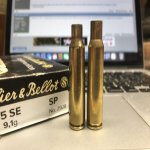So, my first reaction to that picture was that you have stuck a 6.5 bullet into a 7mm bore, or something. I hope that you have good reason to know that your 94/14 is still chambered to 6.5x55, like it was originally. I don't think I have seen any Swede rifles that bad, but likely mid 1950's since Swede military had anything to do with it.
The usual theory is that the bullet is close to the groove diameter, and therefore the lands (riflings) have to cut into the bullet jacket to make it spin. I do not know the specs for Swede 6.5x55, but for example a 7.62 NATO will use a .308" bullet - should be close to that groove diameter - and riflings are cut .004" deep - so a .300" hole is bored through first. I presume Swede 6.5 are done similar, but I do not know the numbers for it. Some bullet designs also "slug up" - with the push from behind, their base gets fatter to seal better to the grooves. So the usual description of "slugging a bore" is to push a soft lead slug through from one end to another - that gives you a "reverse imprint" on the slug - so long as you have 2, 4, or 6 riflings - just measure from one side to the other to find out your "groove diameter" - should be quite close to what the fat part of your bullets measure. If you have 3 or 5 riflings, is a bit more complicated to measure, since they do not line up across the centre from each other. You need to be able to measure accurately to at least .001" - to .0001" is better - so probably want to use a micrometer, not a calliper - and likely want to repeat both the slug and the measuring a couple times, to be sure.
The soft lead slugs will not change over time, and is for sure the traditional way to establish the groove size. Can do a slug just into the "free bore" area and back out. Can go just into first inch of rifling and back out - all gives you different information about different parts of your barrel's bore. Some of us prefer to do cerrosafe casts, into the chamber throat and first part of rifling, or into the muzzle - can only get an accurate measurement at the 60 minute mark because the stuff continues to swell over time, and next days measurements will be larger than the 60 minute measurement.
Too boot, pushing the slug all the way through will tell you only the smallest place along the bore - the tightest "squeeze" that it went through along it's trip. You might even feel that as you do the slug - a section of the bore that feels tighter than before - sometimes can even feel that when you are cleaning with a snug fitting patch on a jag. That is one piece of the puzzle. The other important part is to press a slug maybe one half inch into muzzle and then back out again - gives you the muzzle diameter - the exact point where the bore should "let go" of the bullet. Some rifles have seen sloppy use of a metal cleaning rod - inserted into the muzzle - or same can be done with the cord on a pull-through type cleaner - eroding away the rifling at the muzzle - makes it larger than it used to be. So far as I know, that muzzle condition is pretty critical to how the bullet flies once it leaves the barrel - that "crown" wants to be square to the centre of the bore, and wants to release the bullet evenly - all the way around, at the same time. About worst is a ding or chunk missing - most likely causes the bullet to start tumbling end over end due to very uneven release.
There was an old technique called "back boring", I think, that essentially drilled out the bore, back into the barrel, and re-established a "crown" back inside where the rifling was still "good". Not sure if militaries did that, but has been done on some older or abused guns to restore some level of accuracy. If your rifle barrel has been "back bored" already, that would explain why that bullet went in so deeply - but I take your post to say that you see rifling at the muzzle, so that is not likely the case. The back boring that I have seen takes at least half or more of the existing barrel wall when that bore is drilled out - i do not know if that is how a "pro" does it or not.










































































